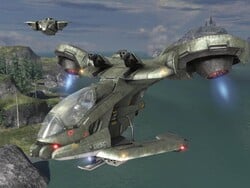AV-14 Hornet: Difference between revisions
From Halopedia, the Halo wiki
(→Trivia) |
|||
| Line 87: | Line 87: | ||
==Sources== | ==Sources== | ||
<references /> | <references /> | ||
The hornet cant carry vehicles | |||
== Related Links == | == Related Links == | ||
Revision as of 19:34, February 26, 2008
Template:Ship The Attack VTOL-14 Hornet[1] (abbreviated AV-14) is a United Nations Space Command atmospheric air vehicle. It fires rockets and has a built in machine gun. It is also capable of carrying two passengers on its sides.
Appearance & Use
The Hornet consists of a one-man cockpit which makes up most of its mass, and a rear section extending a meter or so backward. From the top of this rear section are a set of wings with what appears to be a jet engine/turbo fan at the ends, providing the Hornet's main source of propulsion. It also seems to possess TADS [Target Acquisition and Designation System] gear on the nose similar to modern attack helicopters such as the AH-64 Apache. On each side of the cockpit is a jump seat extending backward (doubling as a landing skid), which allows up to 2 passengers to fire from the sides. It is slightly longer in length than the Covenant Banshee, and its wingspan is larger as well.[2] Unlike the Banshee, the Hornet can remain stationary in the air, but it lacks the evasive maneuvers of the Banshee, and cannot train its weapons on targets.
The controls for the Hornet appear to be similar to those of a helicopter, suggesting that as turbine driven VTOL craft became more practical they replaced helicopters. The Hornet is most likely used in a supporting role to larger VTOL craft, such as the Pelican dropship, or the Sparrowhawk, though the latter appears to have a similar role. The Hornet is pretty much a gunship or a close air support aircraft, like the modern-day AH-64 Apache or the AH-1 Cobra helicopters of the US Army and Marine Corps, respectively.
Though Hornets are visible dogfighting Banshees for most of the early levels, they are only available for use by the player twice, in the campaign level The Covenant. In the first appearance, they are used to move quickly from one location to another, with air-to-air combat in between. Later in the mission they prove to be particularly useful in regards to taking down Scarabs as they can hover in position to destroy the power core, or remove any Brutes on the Scarab.
The Hornet can be used in custom games in Halo 3 multiplayer, but presently is not a vehicle in any matchmaking gametype. [3]
History
Hornets were used as early as 2524, during Operation: TREBUCHET when were used to ferry Marine strike teams from target to target, as well as evacuating wounded men. In Halo: Contact Harvest, Sergeant Johnson used an M99 Stanchion Gauss Rifle mounted on the wing of the Hornet he was mounted on. It was attached to the stub-wings by a cord, and he could free aim it. Given the recoil of this weapon is likely tremendous it is possible that it was mounted on an armature or pintle mount, suggesting other weapons such as M247 GPMGs could be mounted for passenger use.
Hornets had not been observed after that until much later, during the Second Battle of Earth in 2552. They provided air cover throughout the battles at New Mombasa and Voi. Several Hornets were later brought to the Ark and fought against enemy Banshee formations during the Battle of the Ark.
Armament
In respect of weapons, the Hornet is similar to its Covenant cousin, featuring both anti-infantry and anti-vehicle weapons. These consist of two three-barreled rotary chain guns, which seem similar to the AIE-486H Heavy Machinegun, mounted on either side of the cockpit, on the underside of the wings. The anti-vehicle capabilities of the Hornet comprise of two six-missile pods on the underside of the jumpseats, which fire dual missiles much like those fired by the Missile Pod; however, the missiles are weaker, easier to avoid, and, like the missile pod, it's missiles lock onto enemies.
Differences from the Banshee
- A Hornet's rotary chain guns are more effective against vehicles than a Banshee's plasma cannons.
- A Banshee's Fuel Rod Gun has splash damage, therefore being more useful against infantry than the missile pods, however the missile pods' lock-on capabilities (against vehicles) evens the playing field.
- Hornets can hover, whilst Banshees are always moving forward slightly.
- A Banshee has evasive rolls and flips to avoid enemy fire. Lacking these, Hornets are easier targets.
- Hornets can carry passengers, and are much harder to board than Banshees.
- Hornets lack a boost, which can propel the Banshee across a map very quickly.
- Hornet's missiles work well if driving into in mid-air as long as the target does not move, the Banshee's Fuel Rod Gun once fired the driver can evade any attacks coming at it.
- Hornets are best in air to air combat if using the rotary chain guns.
Trivia
- The Hornet does not currently appear on any Multiplayer Levels by default, and can be added through Forge.
- The Hornet bears a resemblance to its namesake insect with the "wings" growing slightly wider towards the end (like a real hornet's wing) and with the personnel jump seats mimicking the long back legs that often trail behind the insect.
- Though the Hornet can only carry two passengers in Halo 3, Halo: Contact Harvest details two teams of four being carried by only two Hornets, plus pilots.
- The Hornet's jump seats may be inspired by the AH-6J Littlebird.
Sources
The hornet cant carry vehicles
Related Links
Internal
External
